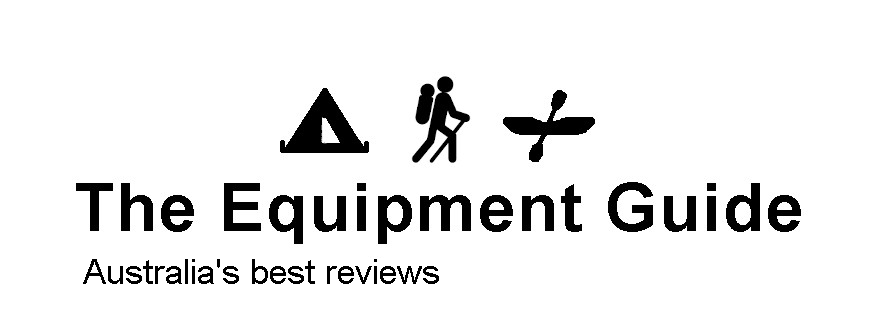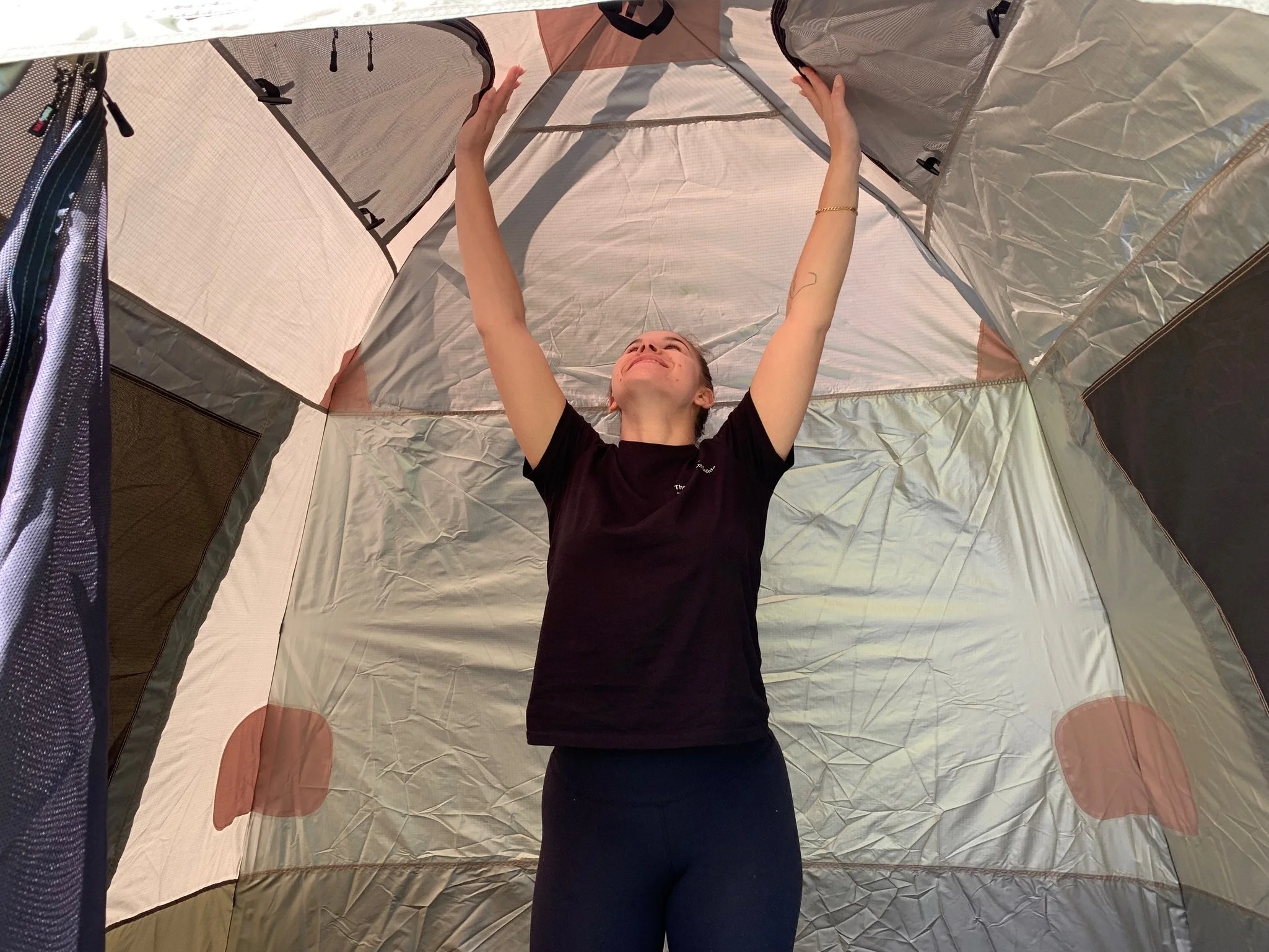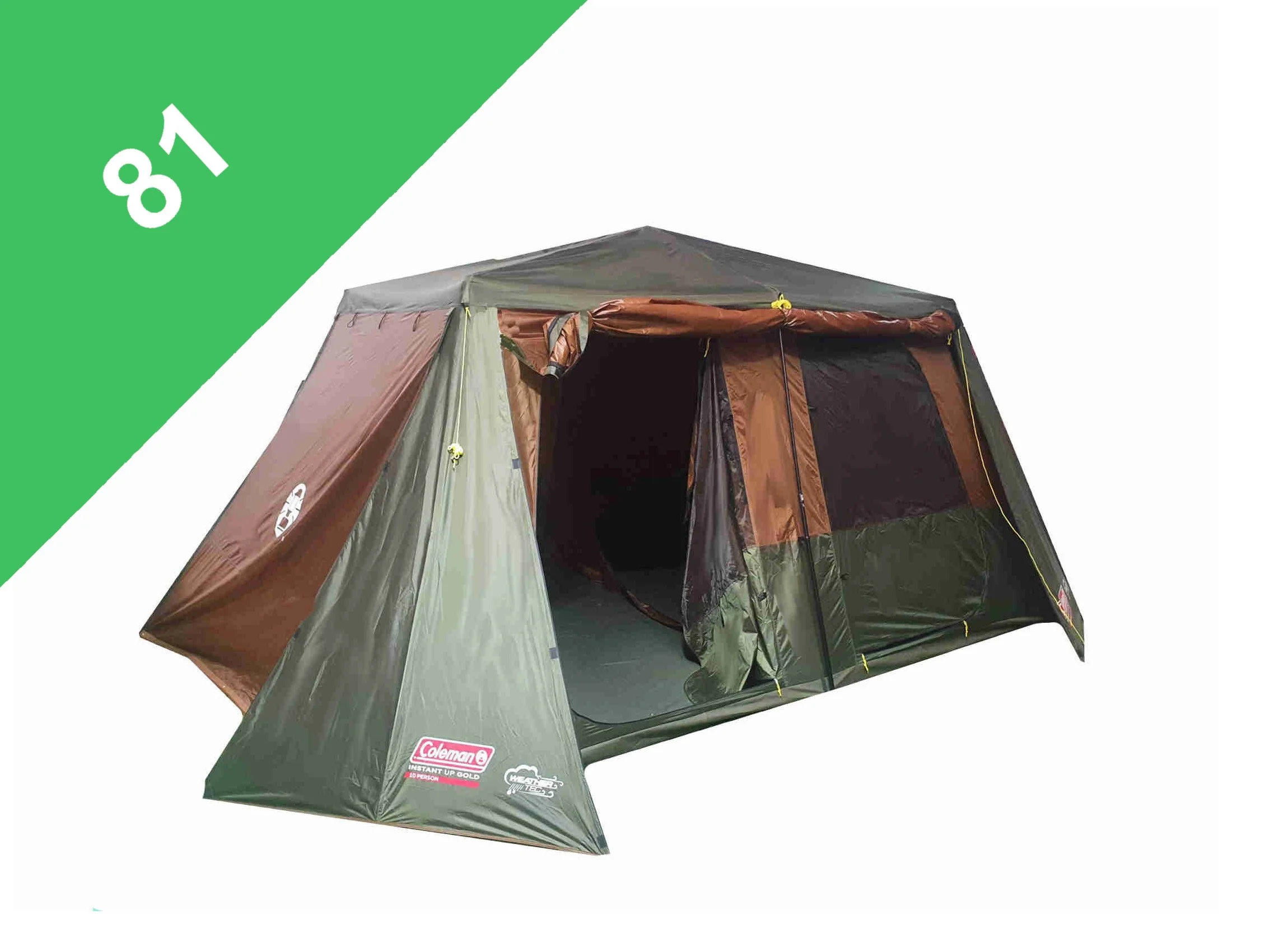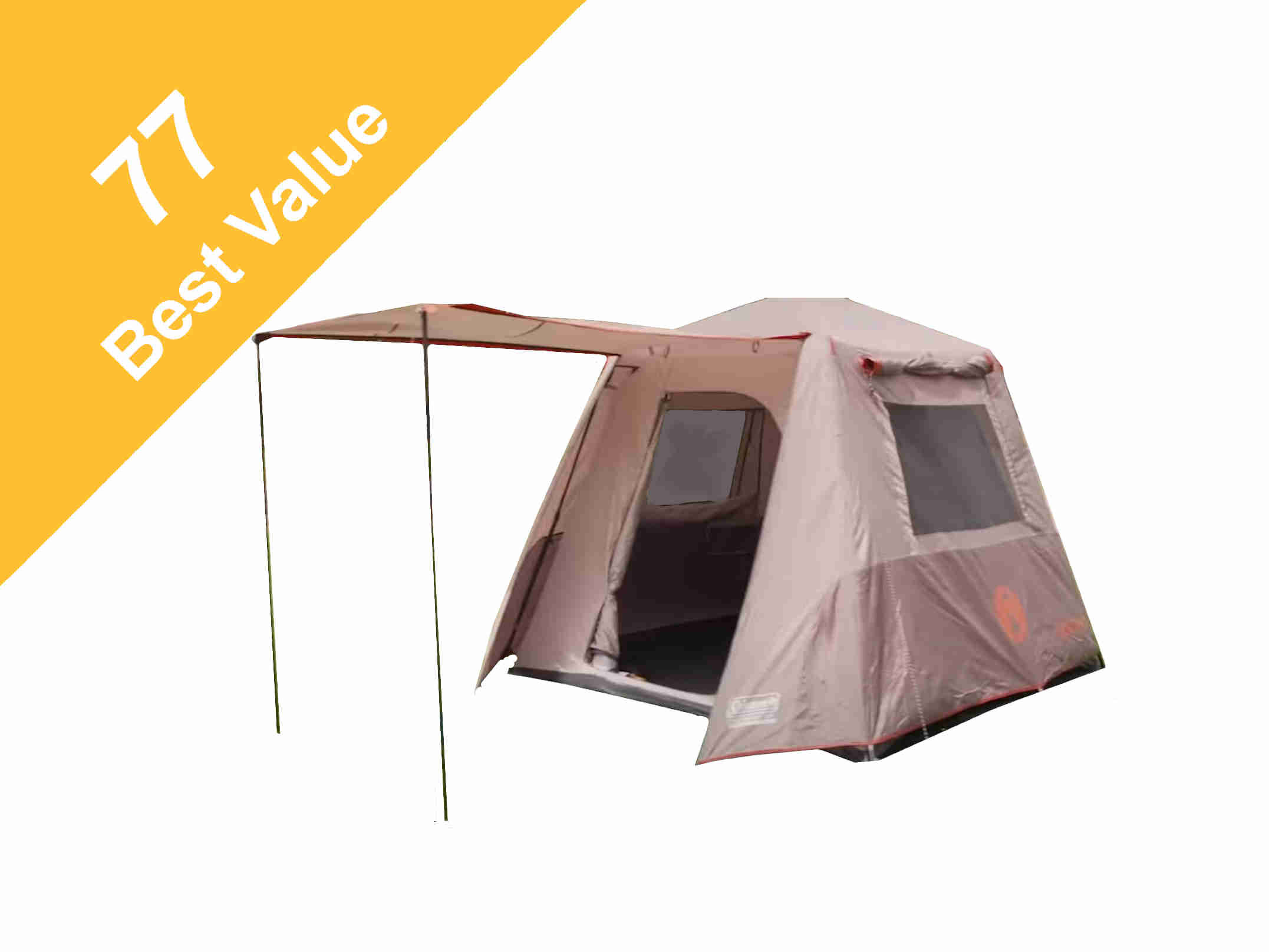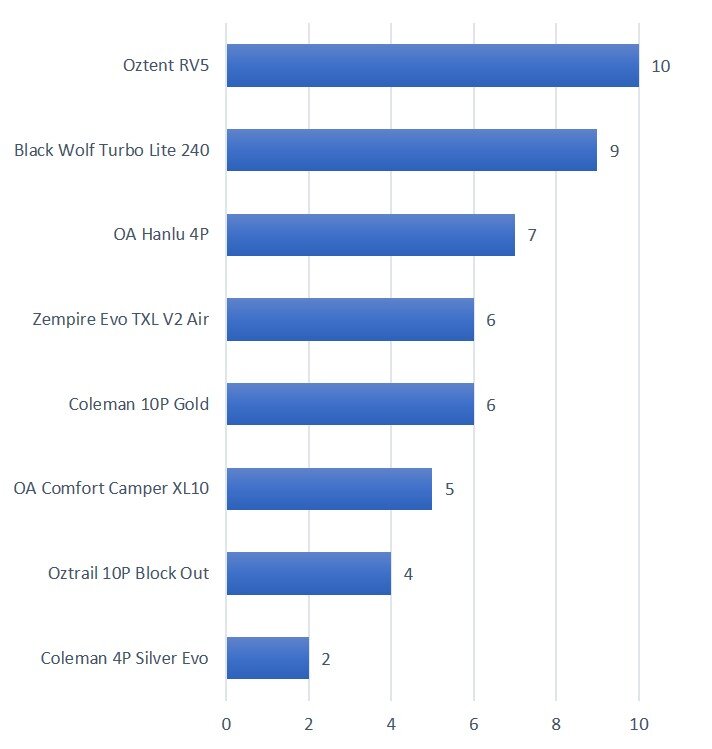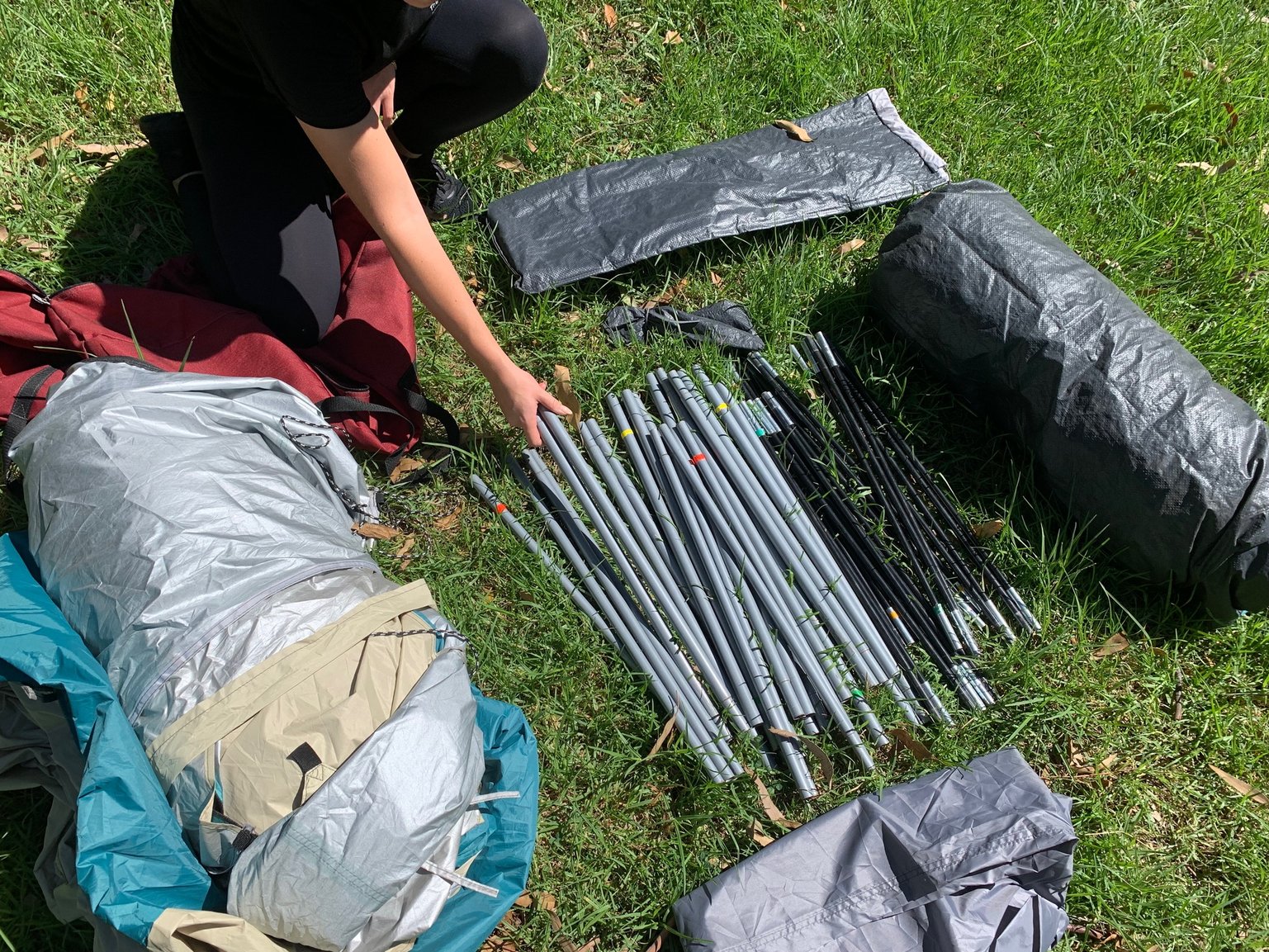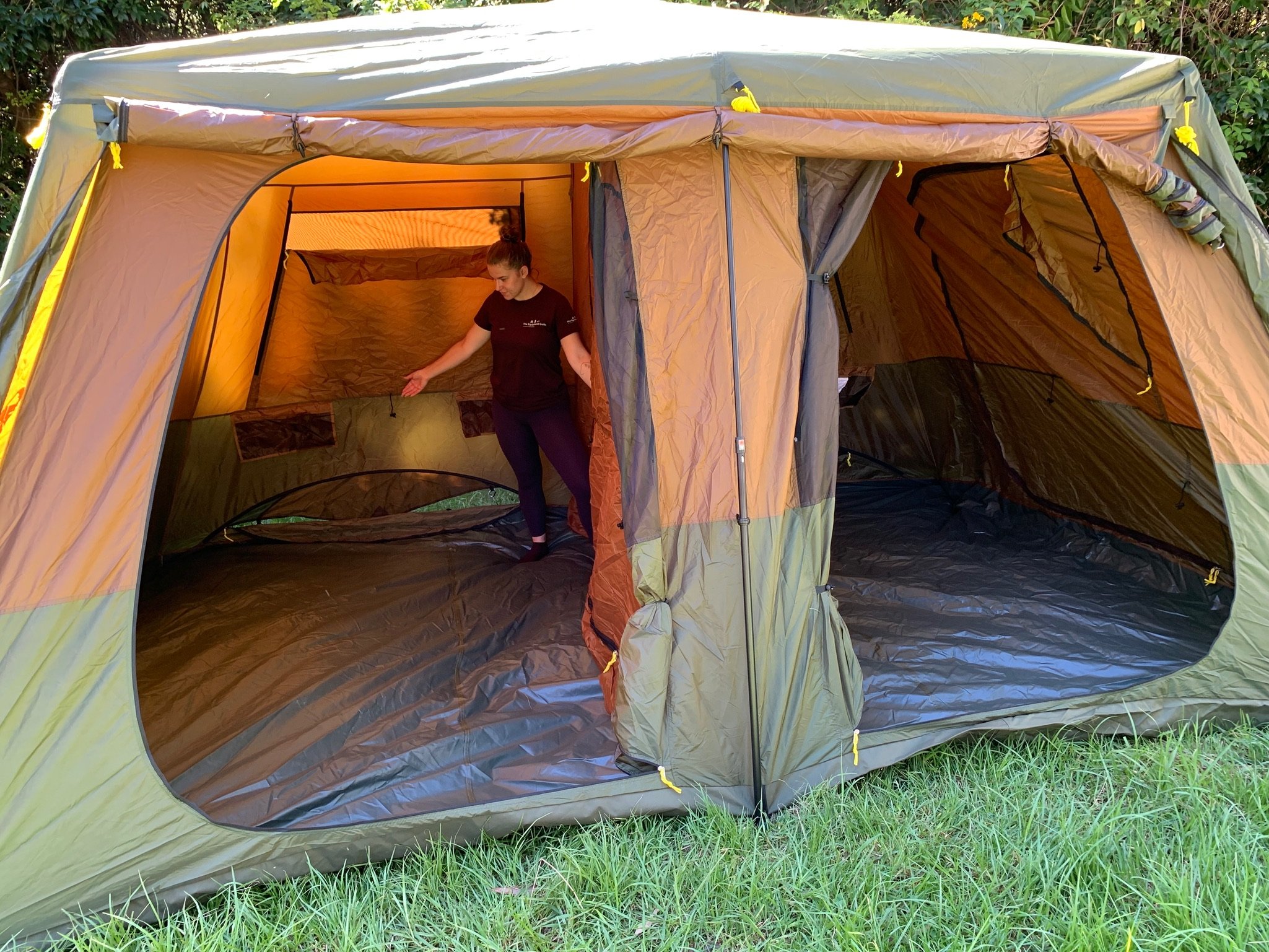Best Family Tents Australia 2025
Tested in Aussie car-camping spots, holiday parks, open fields and beaches.
Whether you're a family planning your first camping trip, a couple needing extra space, or a budget-conscious shopper looking for value, this guide finds the right tent for you. We've hand-picked the best family tents by physically testing them in the field, judging them on key criteria like comfort and space, weather-proof construction, versatile features, ease of setup and overall value. Our recommendations are built on this real-world experience, having assessed over a hundred tents to find the most reliable options for Australian conditions. Watch our video review, or read our comprehensive reviews of each product that be found via the ‘Read Full Review’ buttons below. If you’re looking for bedding for your tent, be sure to check out our list of Best Sleeping Bags!
Our Top Picks:
Best Overall: BlackWolf Turbo Lite 240
Best Budget Family Tent: Coleman 4P Silver EVO
Best for Large Families: Zempire Evo TXL V2 Air
Best for Easy Setup: Oztent RV 5
Updated 25th November 2025: Added Family Tent FAQs
Family Tent Reviews
BlackWolf Turbo Lite 240
Price At Time Of Writing | $899.00
Overall Rating | 91
Comfort | 9
Construction | 9
Features | 7
Size/Weight | 6
Versatility | 10
Packed Size - 121x28x28cm
Weight - 19kg
Sleeping Size - 5.8sqm
Best For - Touring and camping lovers
Pros - Versatile design, robust build
Cons - Awning requires manual setup
Overall - Great for touring and camping trips
Zempire Evo TXL V2 Air
Price At Time Of Writing | $1,799.00
Overall Rating | 90
Comfort | 9
Construction | 6
Features | 9
Size/Weight | 10
Versatility | 6
Packed Size - 75x55x55cm
Weight - 34kg
Sleeping Size - 9.7sqm
Best For - Large family camping trips
Pros - Spacious living area, effortless setup
Cons - Requires ample space for setup
Overall - Excellent for family camping
Oztent RV5
Price At Time Of Writing | $1,199.00
Overall Rating | 84
Comfort | 6
Construction | 10
Features | 8
Size/Weight | 3
Versatility | 7
Packed Size - 202x38x27cm
Weight - 25kg
Sleeping Size - 6.8sqm
Best For - Touring with a roof rack
Pros - Durable construction, quick setup
Cons - Difficult to transport, higher price
Overall - Great for long trips
Coleman 10P Gold
Price At Time Of Writing | $527.90
Overall Rating | 81
Comfort | 6
Construction | 6
Features | 8
Size/Weight | 7
Versatility | 4
Packed Size - 119x33x33cm
Weight - 30kg
Sleeping Size - 12.4sqm
Best For - Budget-friendly family camping
Pros - Affordable, practical features
Cons - Inferior material quality compared to other tents
Overall - Good easy setup two-room budget option
OA Hanlu 4P
Price At Time Of Writing | $499.95
Overall Rating | 81
Comfort | 8
Construction | 7
Features | 5
Size/Weight | 5
Versatility | 6
Packed Size - 115x20x20cm
Weight - 11kg
Sleeping Size - 5.8sqm
Best For - Compact camping setups
Pros - Sturdy frame, simple setup
Cons - Limited features
Overall - Strong easy-up tent, basic features
Oztrail 10P Block Out
Price At Time Of Writing | $699.00
Overall Rating | 81
Comfort | 7
Construction | 4
Features | 7
Size/Weight | 9
Versatility | 4
Packed Size - 116x34x34cm
Weight - 33kg
Sleeping Size - 8.6sqm
Best For - Large group camping on a budget
Pros - Extra-large with three rooms
Cons - Quality of materials used
Overall - An ok XL sized budget tent
Coleman 4P Silver Evo
Price At Time Of Writing | $249.00
Overall Rating | 77
Comfort | 6
Construction | 2
Features | 7
Size/Weight | 4
Versatility | 8
Packed Size - 112x25x24cm
Weight - 12.7kg
Sleeping Size - 5.3sqm
Best For - Compact family camping
Pros: Quick setup, stable, price
Cons: Limited space, low-quality materials
Overall: Reliable for small families going camping
OA Comfort Camper XL10
Price At Time Of Writing | $699.95
Overall Rating | 76
Comfort | 8
Construction | 5
Features | 2
Size/Weight | 8
Versatility | 3
Packed Size - 70x30x30cm
Weight - 17kg
Sleeping Size - 12sqm
Best For - Spacious family camping
Pros - Generous space, sturdy
Cons - Heavy, requires effort to set up
Overall - Comfortable for large families
Watch our in-depth analysis by category
Watch our in-depth analysis by category
Advice we’d give to a friend
The Basics
What size tent should I get? - This will really depend on personal factors but there are typically two basic options: an 8-10 person tent or a 4 person tent. 4 person tents are usually 1 room and 8-10 person tents are usually 2 large rooms or 3 medium size rooms.
How many ‘season’ tent do I need? - In almost all conditions in Australia a 3 season family camping tent is best. 4 season tents are more for very cold/ snowy conditions so unless you are planning on camping in the snow fields or Tasmania in winter, 3 is enough. Another thing to consider is that 4 season tents trap the heat and can get very hot in the warmer months which is when most of us are camping anyway.
How much room do you have in the car and at camp? - Some tents like the Oztent RV5 are 2m long when packed so you need a roof rack to get it around. Others like the Zempire Evo TXL V2 Air have a massive footprint when setup so you will need a decent enough amount of space to set it up at camp.
Are you going to use it for touring or for longer stay camping? - Some tents for families are easier to set up than others so if you are travelling around to a new spot every night something with a quick setup is going to be important.
Canvas vs. Polyester Materials? - This is a well debated topic. Canvas is definitely more durable and some believe that these are the best family tents but they are also heavy and hard to dry. Modern day tents made of polyester type fabrics can be just as good or better in our view so long as they are made with a good density fabric and solid waterproofing.
Budget
When it comes to finding the best family tents we think you can get something decent without dropping a ton of cash. There are always exceptions to the rule but we break the market into three main categories for 8-10 person tents and 4 person tents:
High End (over $800) - This will get you one of the best camping tents for your family. Good quality materials, spacious and durable.
Mid Range (8-10P $400 to $800, 4P $300 to $800) - These tents are typically still going to be easy to set up with decent materials that won’t fall apart on you. Quality can vary between brands in this price range and we find a $700 tent isn’t always better than a $500 tent for instance.
Low Range (8-10P under $400, 4P under $300) - Be careful - you’ll likely purchase something you’ll regret. Poles may fall apart or fabric may not be as waterproof as claimed.
Cabin vs. Dome Tents
Dome tents typically have less head room and are less spacious. For that reason we believe cabin style tents are the best tents for families whether you are camping or touring. All family tent reviews here are for cabin style tents.
Considerations for Australian Conditions
When picking a family camping tent in Australia, there are a few extra things to think about to make sure your tent is comfortable, practical and lasts:
Sun and UV exposure - Australia’s sun can be harsh and even high-quality polyester tents can fade or weaken over time. Look for UV-protected fabrics, and whenever possible, set up your tent in the shade or use a tarp over the flysheet. A UV spray can also help protect the material.
Rain and waterproofing - Due to our unpredictable weather, even a 3-season tent should have a solid waterproof rating (usually 3,000–5,000mm) and sealed seams. Keep in mind that heavy rain combined with wind can test a tent’s durability, so strong poles and a well-fitted fly are essential.
Ventilation and condensation - Humid or warm weather can make tents uncomfortable. A good family tent should have multiple windows, vents, or mesh panels so air can circulate to help prevent condensation, keep the tent cooler and stop damp smells.
Durability in Aussie conditions - Speaking of our weather, strong winds, bumpy ground and sandy beaches can all take a toll. Reinforced floors, solid pole structures and durable fabrics are worth the extra investment if you plan to camp often or in remote locations.
Size and layout for local camping - Think about how you’ll use the tent in Australian parks or beaches. Large 8–10 person tents are spacious but need a lot of flat space, which isn’t always easy to find. Smaller 4-person tents are easier to transport and set up at crowded campgrounds or bush camping spots.
Storage and transport - Some family tents are massive when packed, so check your car space before buying. Roof racks or roof boxes may be necessary for the biggest tents, while mid-sized tents can usually fit in the boot of an SUV or station wagon.
Canvas vs polyester for Aussie camping - Canvas tents are tough and long-lasting, but heavy and slower to dry. Polyester tents are lighter and easier to handle, and modern fabrics can be just as durable if well-made. Think about how much carrying and setup you’ll do versus longevity.
Local repair and warranty support - Buying tents from brands with Australian distributors means you can easily get replacement poles, pegs, or repair kits if something goes wrong. This is especially useful if you’re camping in remote areas.
Safety Checklist
Check Official Warnings: Always check the Bureau of Meteorology for forecasts and fire danger ratings before you go. Never camp in a dry creek bed.
Peg it Right: Use all guy ropes and pegs, especially in wind, as a taut tent handles weather best.
No Food in Tent & Ventilate: Store food in your car to avoid wildlife visits and keep vents open to manage condensation and heat. Wildwalks has great great general advice on low-impact camping and wildlife.
Ratings By Category
Method
After reviewing the market we pick what we think will be the best family camping tents in each category from a variety of retailers. Each product selected gets 50 points automatically just for being selected. We then perform field tests and in person assessments to rank them out of 10 on the following categories: Comfort, Construction, Features, Size/Weight and Versatility.
Rankings are adjusted or weighted based on importance and how much they vary e.g. some categories will be categorised from 1 to 10 whereas others 4 to 9 etc. (although there may be outliers). For the family tent reviews, size/weight and versatility are considered inverse in our reviews. An 8–10 person tent, for instance, isn’t as good for touring, so it is less versatile and a 4 person tent isn’t going to have anywhere near the same floor space as an 8–10 person tent. We have handicapped these metrics in order to provide a level playing field, so if, for instance, you see a 4-person tent getting ranked as a 6 out of 10 for size/weight that may actually be a good ranking.
If you are looking for the best family tents in Australia, this is where we hope to provide you with all the details. We believe good family tent reviews should provide you with all the info you need to decide and we hope you can find that here.
Testing Methodology
All the family camping tents we review are tested hands-on in realistic Australian camping conditions, not just pitched in a backyard, checking how they perform over full weekends outdoors, with weather, ground conditions and real family use in mind.
Once on site, each tent goes through a setup and inspection phase, where we check its build quality, pole and seam strength, zipper durability and how easy it is to pitch and pack down, even with limited help. We also measure packed weight and dimensions to confirm whether they match the manufacturer’s claims.
Then, we subject the tents to a series of real-world performance trials. This includes testing weatherproofing in wind and rain, ventilation and condensation management in both cool and warm conditions (Zempire give some tips about preventing condensation in your tent, if interested), and overall liveability with a family and their gear inside. We examine features like room layout, storage options and blackout capabilities, focusing on how comfortable the tent is to live in from afternoon naps to overnight storms, simulating a typical Australian family camping trip.
Finally, we assess long-term durability and usability by repeating pitch and pack-down cycles, inspecting for wear and tear after use on varied Australian ground surfaces and testing how portable and manageable the tent is for car-to-campsite carrying. Scores across these areas are then weighted into our category ratings, so the overall ranking reflects not just specs on paper, but how the tent performs when your family is tired, it’s getting dark and rain might be on the way.
Want the full breakdown of our testing process? Click the drop-downs below to learn about our detailed methodology.
-
Before we take tents for a camping trip, we check over the family camping tent to confirm construction quality, included components and basic usability.
Unboxing and Component Check - We make sure all advertised parts are included: fly, inner body, poles, pegs, guy ropes, room dividers, awnings, storage pockets and carry bag.
Material and Construction Review - We then check over tent, looking for misaligned stitching, loose threads, poor seam taping, or stress points likely to tear. Some of what we check includes:
Fabric quality (polyester, canvas, ripstop, denier rating)
Stitching, seam taping and waterproof coatings
Zippers, door tracks and ventilation panels
Joinery points and pole connectors
First Pitch Timing and Ease - As everyone should before heading out on a trip, we pitch the tent. We do ours for the first time in calm conditions, timing how long it takes with two testers and following the supplied instructions exactly. This forms our testing baseline for real-world setup. We check for:
Clarity of instructions
Logical pole layout or hub system
Whether clips, sleeves and anchors are user-friendly
Need for pre-reading or trial-and-error
Size, Weight and Packed Dimensions
We then log a range of specs, which are compared with manufacturer claims to detect discrepancies. These include:Total packed weight
Bag dimensions and compressibility
Pole bundle size and material type
-
We then test tents over multiple nights in varied environments, such as powered sites and open bushland, to see how the tent performs when actually camping.
Pitching Under Pressure - We pitch the tent again at a real campsite, sometimes in wind or low light, to simulate realistic arrival conditions (e.g. arriving at dusk). We also make sure to see how intuitive the process is after familiarity with the tent.
Weather Protection (Rain and Wind) - If conditions allow, we camp through rain or use hose testing to test a range of factors. We record any leaks along seams, zippers or roof vents. Some of what we test includes:
Fly coverage and water beading
Seam integrity and floor bathtub performance
Wind stability with fully tensioned guylines
Ventilation and Condensation Control - Across evening to morning, we check how well the tent ventilates, such as monitoring:
Mesh panels, roof vents and airflow design
Condensation buildup on inner tent walls
Whether windows can be partially opened in rain
Internal Space and Layout Functionality - We sleep, move and store gear inside to evaluate:
Room size with mattresses/stretchers
Standing height and head clearance
Door placement, divider practicality and privacy
Awning or porch usability for chairs/cooking
Noise and Light - We also note how the fabric performs overnight, such as flapping or rattling in wind and how much light comes inside (blackout vs bright). This is because families often care about early morning light or midnight disturbance.
-
A good family tent should last more than one season. To give us an understanding of how the tent will fare long term, we put the tent through stress and weather tests. These include:
Seam and Fabric Tension - We apply controlled stress (gentle pull tests) to corner points, guyline loops and door anchors to test reinforcement quality.
Floor Toughness and Abrasion - We inspect the tent’s floor after use on rough ground or peg-driven surfaces, checking for scuffs, punctures or delamination.
UV Exposure and Colour Fastness
When possible, we leave the fly pitched in full sun over multiple hours to check for any fading, fabric brittleness or coating loss.Peg and Pole Durability - Poles are flexed multiple times during setup and pack-down so that we can check for cracking, splintering (in fibreglass) or bending (in steel/aluminium).
-
As family tents are temporary homes for people young and old, it’s important that we test features that affect everyday functionality.
Setup and Pack-Down Repeatability - We perform multiple full cycles of setup and teardown to check:
Whether components jam, snag or deform
Difficulty in folding fly/inner to fit back into bag
How strong or tall one needs to be to set the tent up solo
Storage and Organisation - We check how well the tent supports organised living. This includes the:
Number and placement of internal pockets
Lantern hooks, gear lofts, electrical cord ports
Groundsheet integration in vestibules/porches
Transport and Vehicle Fit - We also see how easily the packed tent fits into standard vehicles (crossover, SUV, wagon) and how manageable the weight is for one person.
Family Friendliness - As these are family camping tents, we have to also check real usability factor, including:
How easy it is for kids to use zippers and doors
Tripping hazards (guy lines, pole hubs)
Entry/exit without dirt or water ingress
-
Each tent is scored across five core categories, each with an equal role in determining the tent’s overall score. These categories include:
Comfort - Focuses on internal space, headroom, temperature control and sleep experience
Construction - Focuses on material quality, seam strength, pole integrity and weatherproofing
Features - Focuses on storage, dividers, awnings, ports and ventilation options
Size/Weight - Focuses on packed weight, bulk, ease of transport and setup by families
Versatility - Focuses on suitability across seasons, weather adaptability and campsite types
Each category is scored (typically out of 10), then normalised and weighted. Exceptional performance in one area (e.g. extreme weather stability or unmatched space) may earn a bonus, while serious usability issues result in deductions.
We use the same bedding gear, peg styles and team members across tests where possible. Weather variables are recorded (temperature, wind speed, rainfall) to provide fair comparisons.
By following this structured approach, our reviews aim to reflect realistic family use to help buyers choose tents that will stand up to real weekends away, unpredictable weather, excited kids and years of holiday fun with the family.
Comfort
Comfort considers three main elements: how spacious it feels, the layout and key design elements impacting liveability.
Most of the tents for families we reviewed were pretty comfortable and there isn’t a huge deal of variation in this category. Some of the less comfortable models like the Oztent RV5 have a big aluminium bar running down the floor while others like the Oztrail 10P Black Out were to dark inside. We understand that is the feature but we prefer to be able to see inside our tent in the daytime. The best tents for families such as the Zempire Evo TXL V2 Air and the BlackWolf Turbo Lite 240 on the other hand have a spacious feel and we’d be happy to spend time in them on a rainy day if needed.
Blackwolf Turbo Lite 240 Spacious Interior
Aluminium Floor Bar In RV5
Construction
Construction essentially looks at materials used and craftmanship. Fabrics and pole materials play a massive role in how breathable, strong and waterproof it will be. There is usually a trade off here between quality and cost.
In a traditional tent important things to look out for are a strong gauge aluminium frame and high denier (density) materials (such as ripstop or canvas) with a good water head rating are typically the best. Cheap tents will use thin gauge fibreglass poles or weak materials so avoid buying those as they will fall apart. The Oztent RV5 and BlackWolf Turbo Lite 240 tick all the boxes. The Zempire Evo TXL V2 Air is not your standard tent being an inflatable but we were surprised with how solid the structure actually was when setup.
Durable Oztent RV5 (right) vs Coleman 4P Silver (left) materials
OA Comfort Camper (left) vs. Black Wolf TurboLite (right) frame
Features
The features category looks at how easy it is to set up as well as some of the basics like storage pockets, hanging hooks and power access points and ventilation.
The Zempire Evo TXL V2 Air was the best family tent in this category ticking all the boxes, with fast setup and having great configuration options it is very liveable. The OA Comfort Camper XL 10 took a long time to set up and the OA Hanlu 4P was missing an electrical inlet. All of the others were fairly comparable, although the Oztent RV5 with its twist-lock poles is very quick to set up. The Coleman 10P Gold also ticks all the boxes and is a great value tent for the family.
OA Comfort Camper XL10 Lengthy Assembly
The Black Wolf Turbo Lite 240 Has Ventilation Windows
Size/Weight
Rankings in this category primarily consider the amount of useable floor space the tent provides. Sleeping configurations, packed size and headroom were also considered. 8–10 person tents will naturally rank higher here and higher on versatility.
The Zempire Evo TXL V2 Air and BlackWolf Turbo Lite 240 were the standouts here in their respective categories. The Zempire is actually the biggest family tent we have seen and it feels like a mansion inside. The Oztrail 10P Black Out also provides good space for the whole family with three rooms (two bedrooms and a small foyer). The Oztent RV5 is 202cm long when packed, so you will need a roof rack as it won’t fit in the boot. If you’re heading somewhere particularly remote, have a read of our best satellite communicator recommendation, especially if you’re camping with kids.
Oztent RV5 2m Packed Size
Coleman 10P Gold Ample Floor Space
Versatility
This category looks at whether we would use the tent for family camping, touring or both. Four-person tents will naturally rank higher here and lower on size/weight.
The BlackWolf Turbo Lite 240 is a great all-rounder that we would happily take touring or on a family camping trip. Easy to set up, durable and with a symmetrical interior and awning this is one of the best family camping tents in a 4-person model. For the price, the Coleman 4P Silver Evo also offers great value that can be used for touring or camping and isn’t a bad option as a tent for the family.
A variety of spaces available in the Zempire Evo TXL V2 Air; an inflatable frame makes it easier to pitch, increasing its versatility
The Coleman 4P Silver Evo has Room for a family and pets
Overall Results
The best family tent for you depends on your budget, the size of your family and the kind of camping you plan to do. If you're after a comfortable base for weekend car camping trips, a spacious and easy-to-pitch model like the BlackWolf Turbo Lite is great, but if you need a budget-friendly option for occasional fair-weather trips, a simpler choice like the Coleman 4P will do the job perfectly.
Still not sure which tent to choose?
Dive into our detailed reviews above to see how they handle real family camping scenarios, and if you're still deciding between a few, get in touch! We're always happy to help you find the perfect home-away-from-home for your family's next adventure.
Family Camping Tent FAQs
How big should a family tent be? - A lot of families underestimate how much space they really need. The ‘person count’ on a tent often only shows how many sleeping pads fit, not how much room you’ll need for gear, kids, or a portable crib. Many people actually buy a tent that’s one size up from how many people they are, just so there’s more breathing room and room to store stuff. Australia Geographic goes into more depth about family tent sizes, if you’re interested.
What type of tent shape is best for a family? - This really depends on how you camp. Some ‘cabin-style’ tents have tall, vertical walls which means more headroom and a very liveable space, which are great for changing clothes, stretching out or using room dividers, but dome tents, with sloping walls, are better in windy conditions because they shed wind more effectively.
How durable do family tents need to be? - If you’re camping with kids (and maybe pets), you’ll want something fairly tough: look for poles made from strong materials like aluminium and a floor that’s reinforced and has taped seams so it doesn’t leak. Cheap tents often skimp on these parts and may leak or fail after heavy use or rough weather.
How do I prevent the tent from getting all stuffy or filled with condensation? - Ventilation is super important: a good family tent should have mesh panels, windows and vents so air can move through. Without that airflow, you’ll likely wake up to damp walls or even puddles of water inside.
Is it hard to pitch a big family tent? - It can be, especially bigger or more complex tents, but there are ways to make it easier. Tents with colour-coded poles or ‘clip-on’ designs let you set things up faster. That said, even big multi-room tents tend to take 10–20 minutes or more if you’re doing it on your own or in bad weather.
How much should I expect to spend on a solid family camping tent? - Your budget depends a lot on how often you camp and how serious your trips are. Quality family tents that stand up to repeated use and weather can cost more, but they’re worth the investment, while cheap tents may leak, have weak poles or poor zippers. If you're just weekend camping with kids, you might be fine with something mid-range, but if you're planning big family adventures, consider spending more for durability.
Are there size limits for family tents at campsites? - In some parks or campsites, the ‘pad’ (the flat spot where the tent goes) has a size limit, so very large tents might not fit. Some families deal with this by splitting into two smaller tents or booking more than one site, depending on the campground’s rules.
About Our Testing Process
Here at The Equipment Guide we write reviews for Australians with the goal of providing a genuine personal assessment of the best products on the market right here at home.
All products are reviewed and ranked in a methodical and careful manner and we assess them on relevant key features. We do not accept free products from manufacturers.
Our mission is simple: To create Australia’s best outdoor gear reviews.
Afterword
We hope you liked our reviews of the best family camping tents Australia has to offer!
Really most of the family tents we reviewed were great and you don’t necessarily have to spend a bundle on the best family camping tents. Our family tent reviews are all designed with Australian conditions in mind. If you would like us to review a product or have any feedback we’d love to hear from you, feel free to drop us a note.
If you do purchase and are out in your family camping tent please share some pics with us we’d love to see you in action.
